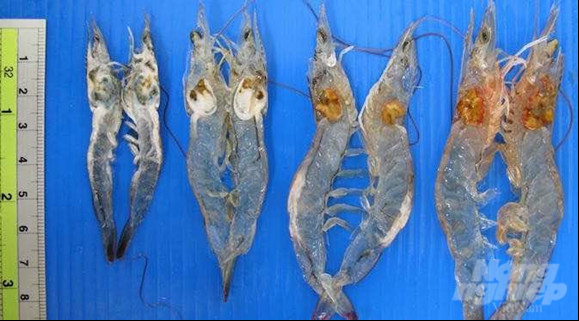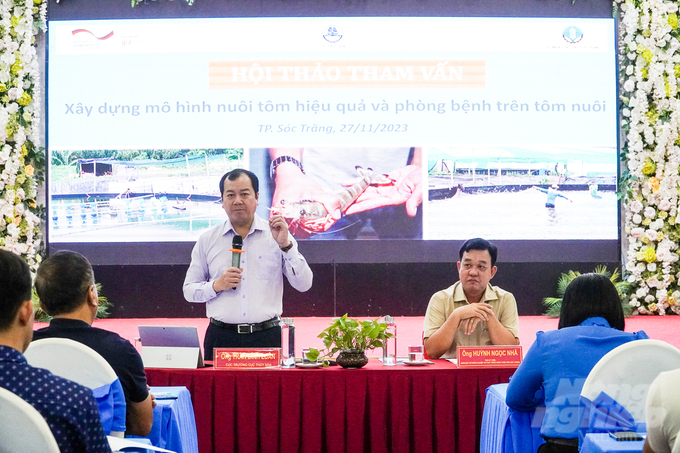November 23, 2025 | 04:24 GMT +7
November 23, 2025 | 04:24 GMT +7
Hotline: 0913.378.918
November 23, 2025 | 04:24 GMT +7
Hotline: 0913.378.918
Diseases in farmed shrimp are a major concern of many enterprises and shrimp farming households in the Mekong Delta in general and Soc Trang province in particular. Statistics from the Department of Animal Health show that up to this point of the year, over 20,000 ha of the shrimp farming area has suffered damage, affecting the production of 20 shrimp farming provinces, down 5% compared to the same period in 2022.
The commonly seen diseases are white spot disease (WSD) and acute hepatopancreatic necrosis disease (AHPND). In particular, enterocytozoon hepatopenaei disease (EHP) has also made its appearance, causing scattered damage in provinces and cities across the country. There is a high possibility that EHP disease will spread and create more losses in the near future.

Samples of farmed shrimp tested for EHP infection. Photo: Kim Anh.
According to statistics from the Sub-department of Livestock Production and Animal Health (Soc Trang Department of Agriculture and Rural Development), the damage rate on farmed shrimp has now been controlled at below 4.4%, down 0.9% compared to the previous year. The damaged areas are scattered in localities mainly because of environmental factors, white spot disease, AHPND, white feces syndrome and EHP.
Results of analysis of damaged seafood samples by the professional sector reveal that the rate of white spot disease, AHPND and EHP is relatively higher in comparison to the same period last year. Most of the farmed shrimp is damaged from June to August, peaking in July. Heavy rains cause a sudden decrease in salinity which leads to water stratification. Toxic gases increase rapidly due to the decomposition of algae, organic humus, and the local lack of oxygen, resulting in the farmed shrimp going into shock.
Recently on November 27 in Soc Trang province, the Department of Fisheries (Ministry of Agriculture and Rural Development) organized a consultation workshop on building an effective shrimp farming model and preventing diseases in farmed shrimp. Huynh Ngoc Nha, Director of Soc Trang Sub-department of Agriculture and Rural Development, said at the workshop that the 2023 shrimp crop faces many difficulties, and the progress of shrimp seed stocking is 9.1% slower than last year’s crop.
“The objective reason is that the rivers are late to reach a favorable salinity level, plus the price of raw shrimp is continuously decreasing. Meanwhile, the cost of input materials such as feed, seeds, environmental treatment products has increased, greatly affecting the production efficiency of many shrimp farms in the province,” said Director Huynh Ngoc Nha.

The consultation workshop on building an effective shrimp farming model and preventing diseases in farmed shrimp was recently organized by the Department of Fisheries (Ministry of Agriculture and Rural Development). Photo: Kim Anh.
“EHP disease spreads silently and violently. The EHP infection rate in hatcheries in Vietnam is extremely high at the moment,” said Hoang Thanh Vu, Sao Ta Foods Join Stock Company.
Regarding the current shrimp farming process, Sao Ta Foods JSC has basically solved the problem of EHP disease in farms. Even when the shrimp is infected with EHP from water sources, its ability to resist the disease is fairly high.
Therefore, if shrimp seeds after 20 days were detected to be infected with EHP, it is very likely that the problem lies in the hatchery. The method of checking and testing for EHP disease on shrimp is still not appropriate, the number of shrimp seeds sampled for testing is too small compared to the scale of the farm.
Sharing the same opinion, Vo Van Phuc, General Director of Vietnam Clean Seafood Corporation also believes that that EHP disease comes from hatcheries. “The seed quality management is ‘very bad’, diseased seeds are all over the market. Companies may be capable of controlling the disease situation, but it will be difficult for farmers”.

Common dangerous diseases in shrimp today include white spot disease, AHPND, and EHP. Photo: Kim Anh.
Along with choosing reputable seed suppliers, Vietnam Clean Seafood Corporation has researched the time to stock seeds at the end of the rainy season (from December to April of the following year). This company also provides a comprehensive solution for treating and preserving clean water sources, focusing on environmental hygiene and disease prevention while combining biosafe measures.
"The seed is of utmost importance. If you do the other steps well but the shrimp seed is infected, you will surely suffer because there is no way for the shrimp to reach the finish line. The loss would be massive. We hope that state agencies will have measures to maintain the disease-free seed source since the current control work is not strong enough," said General Director Phuc.
Translated by Samuel Pham

(VAN) Results from the Sustainable Durian Model Project in Dak Lak have confirmed the critical role of Yara Viet Nam in transferring advanced nutritional solutions to farmers.

(VAN) In Tuyen Quang province, livestock farmers have introduced effective models and innovative practices that significantly strengthen African Swine Fever prevention and control efforts.

(VAN) This is the study conducted by IRRI and Can Tho University on the rice straw value chain in Mekong Delta showing an economic potential of more than 6.6 trillion VND/year.

(VAN) By participating in cooperative economics, many farmers in Tay Ninh have overcome hardship, mastered clean dragon fruit cultivation techniques.

(VAN) The crossbreeding program in the former Binh Dinh province (now part of Gia Lai) has shown signs of decline, and urgent measures are needed to revive it and sustain past achievements.

(VAN) The agricultural sector agreed on a roadmap to pilot the MRV protocol and expand low-emission rice production from the 2025-2026 winter-spring crop.

(VAN) Agricultural extension officers in Quang Ninh do more than transmit knowledge; they have become a steadfast support system for farmers on the path to sustainable agricultural development.